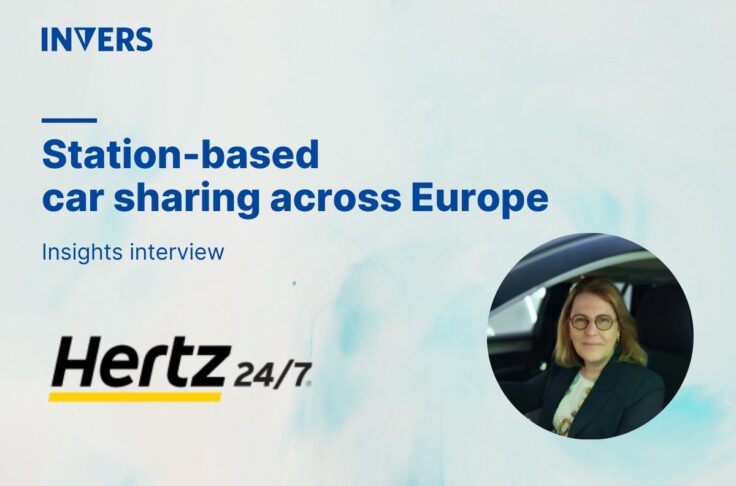Top 5 Solutions to Detect Smoking in Cars

Summary
It is a huge operational challenge for car sharing operators to detect smoking in cars. Cigarette stubs and smoke smell not only degrade the experience for non-smoking customers, but they also cause massive cleaning costs for operators. In this article, we will explore the top solutions to identify smoking and fine offenders to enforce no-smoking policies. Starting with basic customer feedback based on their experience, up to advanced automated technology detecting smoking incidents in real-time.
Table of Contents
- The Everyday Life of Customer Service Managers
- Solutions to Detect Vape and Cigarette Smoke in Cars
- 1. High-Frequency Cleaning & Ozone Cleaning
- 2. Relying on Customers for Reports
- 3. Regular Inspections by Employees
- 4. Nicotine Tests for Surfaces
- 5. Automated Smoke Detection
- Stop smoking and drive profitability
The Everyday Life of Customer Service Managers
Have you ever asked yourself what the work of a customer service manager at a car sharing company looks like? Let’s look at Clara. She works hard to improve customer experience at the local operator by analyzing customer feedback related to vehicle conditions. But each week on Monday, she gets frustrated by the overwhelming wave of complaints.
The weekend sees the highest car sharing usage rates in her hometown, which is reflected in the vehicle condition. People leave empty bottles, trash, and cigarette butts in the car. Recently, the total number of smoking incidents per week has also increased significantly. As the days get shorter and the temperatures drop, smokers tend to light their cigarettes in their cars instead of going out into the cold rain. No matter if it is their own car, a rental car or a shared one.
In rented and shared vehicles, smoking is not only a violation of regulations, but it also results in high cleaning costs and workload for operators. The sheer volume of complaints about smoking leads Clara to question why some rude minority of customers is ignoring the smoking ban. There must be a reliable way to detect smoking in cars, issue fines to customers who break the rules and thereby protect non-smokers.
Solutions to Detect Vape and Cigarette Smoke in Cars
These are questions that many car sharing operators and car rental companies face on a daily basis. Smoking has become a major challenge for operators, resulting in high maintenance costs and a poor user experience for non-smokers.
We have identified 5 solutions that can help Clara and any other car sharing business to identify smoking incidents in cars. Stay tuned to explore the pros and cons of each solution and which business model they are best suited for.
1. High-Frequency Cleaning & Ozone Cleaning
Intense cleaning on a daily or weekly basis is an obvious answer to keep your shared or rental cars in good condition. However, this is more of a post-smoking solution as it focusses on eliminating smoke residue from the vehicle.
All vehicles are cleaned in this procedure, regardless of the degree of soiling. During each session, cleaners employ high-quality cleaning products specifically designed to neutralize smoke particles and remove residues.
After the standard cleaning, an ozone generator can be used inside the vehicle. This device produces ozone (O3), a molecule that interacts with smoke particles and breaks them down at the molecular level. This process typically lasts a few hours, ensuring thorough reach in all nooks and crannies of the interior. After the treatment, the vehicle is ventilated properly to ensure all residual ozone is expelled, making it safe for the next user.

Which Car Sharing Operators Should Use It?
High-frequency cleaning and ozone cleaning to detect smoking in cars is best suited for premium services where customers expect immaculate cleanliness. It requires significant financial resources to set up a proper cleaning schedule.
Pros
- Top-Notch Vehicle Condition: Frequent cleaning helps maintaining vehicle quality despite heavy usage
- Effective Smell Elimination: Ozone cleaning is highly effective at breaking down and removing smoke particles, ensuring a fresher, cleaner vehicle
- Improved Customer Satisfaction: Regular cleanings and ozone treatment create a more pleasant experience for users, boosting overall satisfaction and retention
Cons
- Cost: High-frequency cleaning and ozone treatments can be expensive, impacting budget allocations for operators
- Downtime for Vehicles: During the cleaning and ozone process, vehicles must be out of service, which can lead to reduced availability for users
- Potential for Ozone Overexposure: If not ventilated properly post-treatment, residual ozone can pose health risks. Proper protocols must be rigorously followed
2. Relying on Customers for Reports
As smoking customers won’t ever self-report their misbehavior, you need to get your feedback from other, unsatisfied customers. Some operators use in-app or email surveys to collect feedback. Others rely on real-time app notifications after a ride, where customers receive a prompt to provide feedback specifically focused on smoke detection and overall vehicle cleanliness.
It is also an option to implement simple buttons into the app, allowing customers voluntary action to report once they recognized smoke odor. All this data helps operators to identify vehicles with many smoking incidents.

Which Car Sharing Operators Should Use It?
Especially large-scale operators with a wide user-range can leverage vast amounts of feedback to quickly identify and resolve common problems. On the other side, budget-conscious as well as free-floating operators can benefit from a cost-effective method for monitoring vehicle conditions without substantial investment in technology or labor.
Pros
- Cost-Effective Monitoring: Low-cost method to continually monitor vehicle conditions without frequent physical inspections
- Direct User Insights: Gain firsthand insights from the people who experience your service, providing real-world data on issues like smoke detection
- Improved Customer Relations: Engaging with customers and acting on their feedback enhances overall satisfaction and loyalty
Cons
- Subjectivity: Feedback can be highly subjective and may not always accurately represent the vehicle’s condition
- Unreported Cases: If a car is idle for a long time after a rental, customers might not notice the smell, but it still builds up over time in the seats
- Lack of Immediacy: The last customer to rent the vehicle does not have to be the one who smoked. There may have been several rentals after smoking before a customer complains
- Implementation Resources: Setting up, managing, and analyzing feedback systems requires resources and coordination, which might strain smaller operators’ capabilities
3. Regular Inspections by Employees
Prior to establishing a regular cleaning schedule, it is possible to implement a regular inspection schedule based on individual intervals. If you have a lot of funds and long rentals, you can check after every trip. If you do shorter rentals and have few employees, you may only be able to check once every few days or weeks.
Employees try to identify cars someone had smoked in to reduce the build-up of smoke odors and contaminants based on the vehicles’ smell. Detailed checklists help to ensure thorough assessment of potential smoke damage, odor, and overall vehicle cleanliness. Once your employees detect smoke or cleanliness issues, they can take immediate steps to clean the vehicle or escalate it to a deeper cleaning process.

Which Car Sharing Operators Should Use It?
Regular inspections are most suitable for station-based car sharing operators. Especially local or regional business can benefit from their smaller territories to implement and manage regular inspections by a dedicated team. They are able to consolidate their resources to a few drop-off locations, saving time and money. Premium operators can offset the additional personnel costs with higher rental prices.
Pros
- Hands-On Monitoring: Provides a tangible, real-time assessment of each vehicle’s condition, catching issues early before they escalate
- Quality Assurance: Regular inspections ensure that service standards are consistently met, enhancing customer satisfaction
- Better Culpability Allocation: Although it’s not 100% reliable and depends on the inspection frequency, regular vehicle checks by employees help narrow down which customers could have smoked in the vehicle
Cons
- Resource Intensive: Requires significant effort and time to conduct regular inspections, which can be a logistical challenge
- No Solid Evidence: The people doing the inspections might not notice the smell because they are in a hurry or because they’re smokers themselves
- Operational Downtime: Vehicles need to be taken out of circulation for the duration of the inspection, potentially reducing availability for users
- Limited Business Models: Only applicable for station-based car sharing operators
4. Nicotine Tests for Surfaces
If you like to use a more advanced way of regular inspections, nicotine test for surfaces might be a good solution for you to detect smoking in cars. You no longer rely on your employees’ trying to smell smoke, but you have solid evidence. These tests allow for collecting surface samples from the vehicle’s interior, changing the color of a reagent when nicotine is detected.
The A-pillar is the best area to start testing since that’s where the cigarette is held and most smoke drifts. Other high contact areas such as seats, dashboards and door handles may also be a first choice for testing. Once nicotine is detected, the car can begin the deep cleaning process.

Which Car Sharing Operators Should Use It?
Similar to the third solution, nicotine tests are also best suited for station-based operators with sufficient staff resources and premium services that want to support their employees with reliable tools to identify smoking incidents. Nicotine tests also become interesting to operators that are in the resale process at the end of the vehicle rental lifecycle. They can use it to prove the cars were always smoke-free.
Pros
- Accurate Detection: Nicotine tests provide specific, measurable evidence of smoking that can confirm or refute suspicions, leading to targeted remediation
- Policy Enforcement: Clear evidence from tests can help operators enforce non-smoking policies more effectively and fairly by correlating violations with tangible evidence
- Customer Confidence: Demonstrating the use of rigorous testing procedures can build trust with customers, ensuring them of a smoke-free environment
Cons
- Cost of Testing Kits: Regular use of nicotine testing kits can become costly, especially for large fleets requiring frequent testing
- Increased Vehicle Downtime: Time-consuming cleaning with test kits can delay vehicle availability for users
- Labor-Intensive Process: Performing tests on multiple vehicles needs many employees and does not scale well
- Potential for False Positives/Negatives: While reliable, chemical tests are not infallible and can sometimes produce false results, leading to unnecessary actions or missed detections
5. Automated Smoke Detection
The most sophisticated solution you can use is an automated smoke detector. Sensors are being installed within the vehicle interior, most commonly on the windshield. These sensors are connected to the telematics unit, which enables real-time access to data on smoking incidents.
The sensors are designed to continuously monitor air quality within the vehicle. When smoke particles exceed pre-established thresholds, the sensors will generate an alert. It immediately notifies the relevant fleet operators via the software layer or app, allowing prompt action to be taken.

Which Car Sharing Operators Should Use It?
Automated smoke detection is best suited for technology-forward operators that embrace advanced technology to maintain high standards of service and operational efficiency. Operators experiencing repeated problems with users smoking can enforce their no-smoking policy effectively, so that customers feel like the rules are actually important and not just suggestions. Automation scales well, it provides a practical solution for large fleets where manual inspections and consistent monitoring would be a challenge.
Pros
- Enhanced Vehicle Condition: Real-time monitoring of smoking and vaping allows for minimizing the time smoke remains in the vehicle and the overall smoking frequency in the fleet, resulting in cleaner cars and maintaining resale value
- Scalability: Automated systems can easily be scaled across large fleets, ensuring consistent monitoring regardless of fleet size
- Telematics Integration: Operators receive information on smoking incidents, vehicle status and usage data directly via their Fleet Management Tool to get strong evidence
- User Accountability: Provides concrete evidence of smoking violations, making it easier to enforce policies and charge penalties while proving the non-smoking policy to other customers
Cons
- Implementation Downtime: Because the sensors have a long lifetime and an easy installation, the implementation of the Smoke Detection modules cause minor downtime
- Vandalism: Malicious customers may attempt to remove the sensors in order to smoke undetected
Detect Smoking in Cars and Drive Profitability
These are 5 solutions that can detect smoking in cars. Not only for Clara and her local car sharing operator, but also for your business. Some solutions fit better to a smaller operator that cannot rely on massive financial resources, others are designed for larger operators seeking operational excellence and scaling options.


